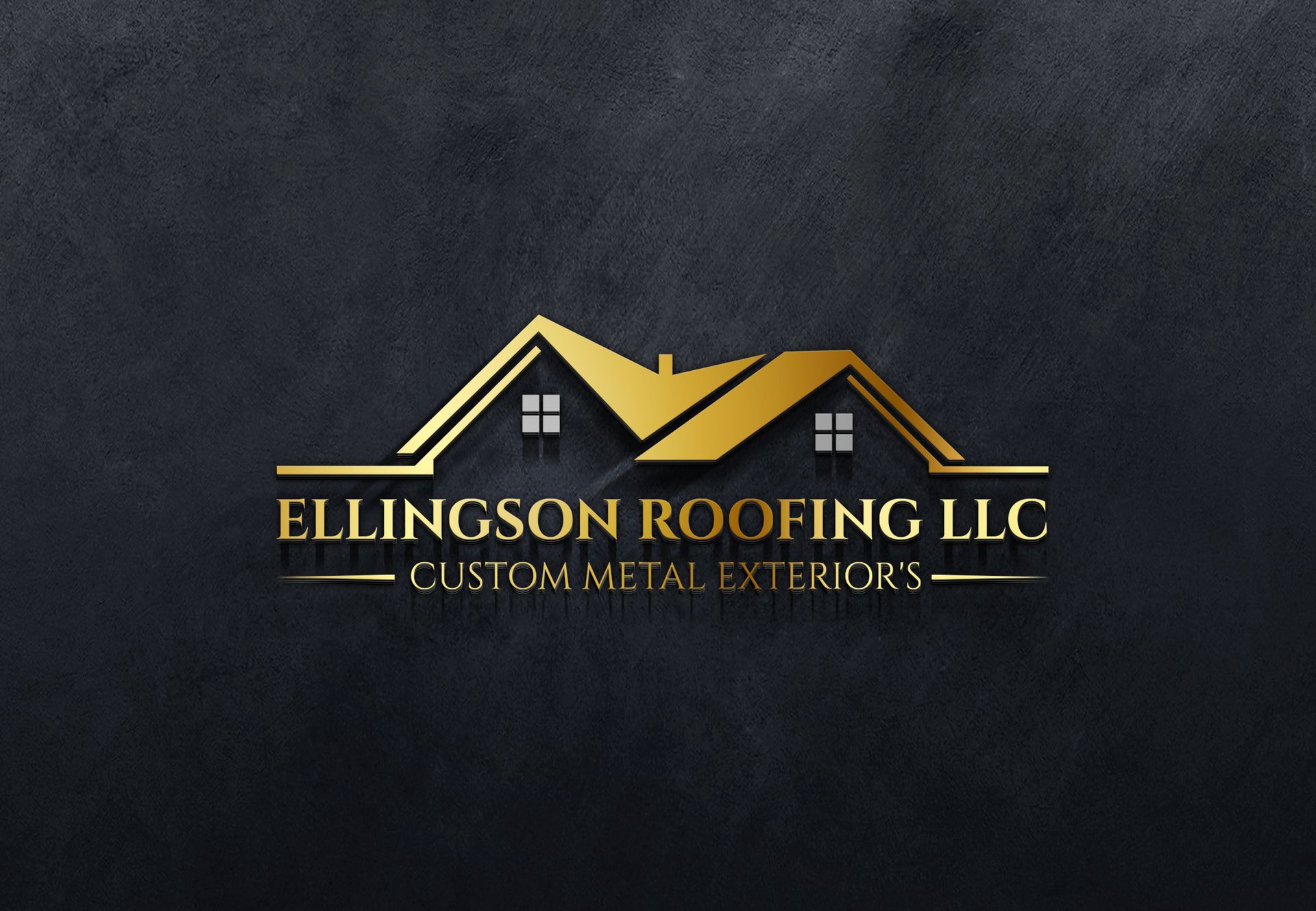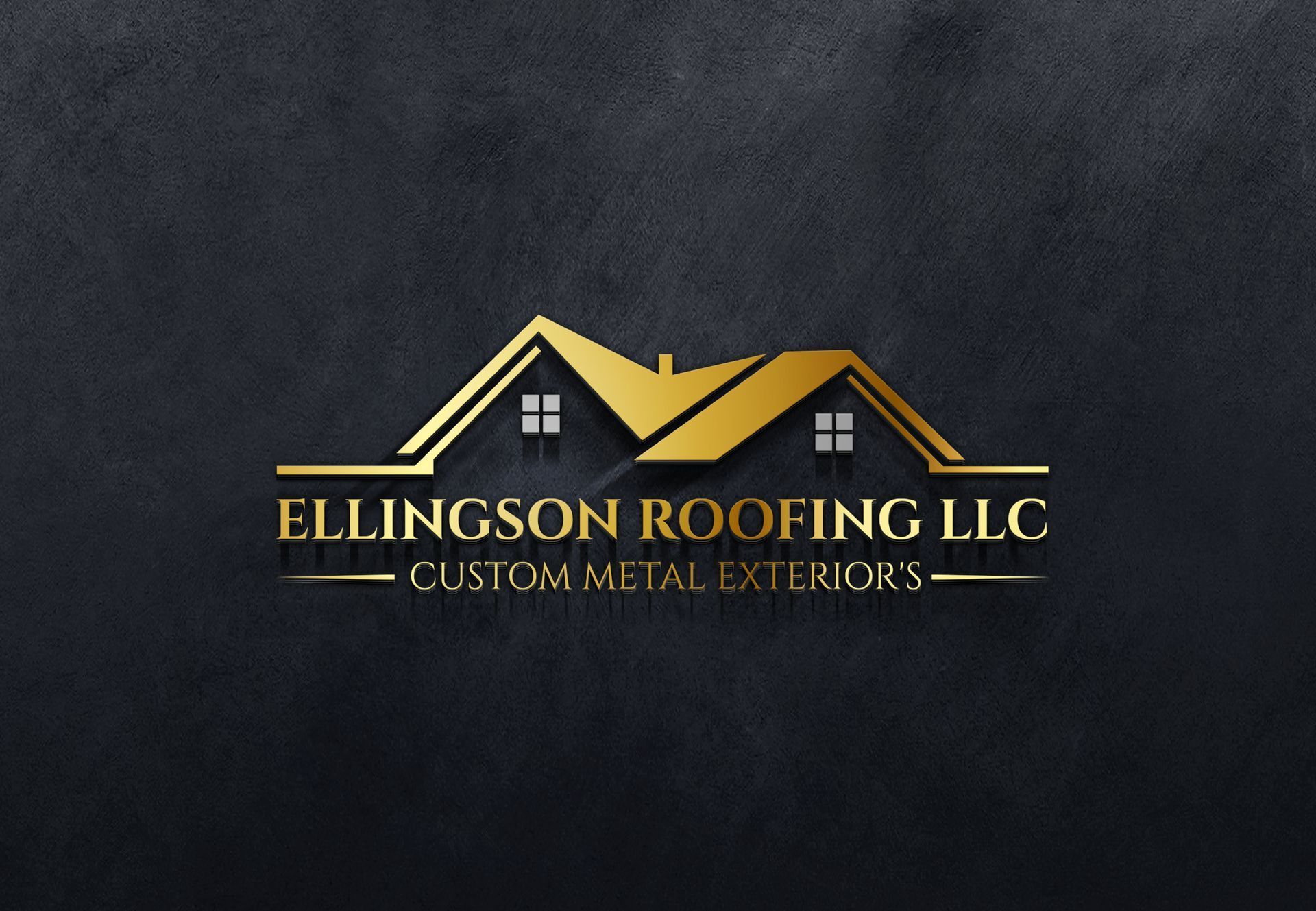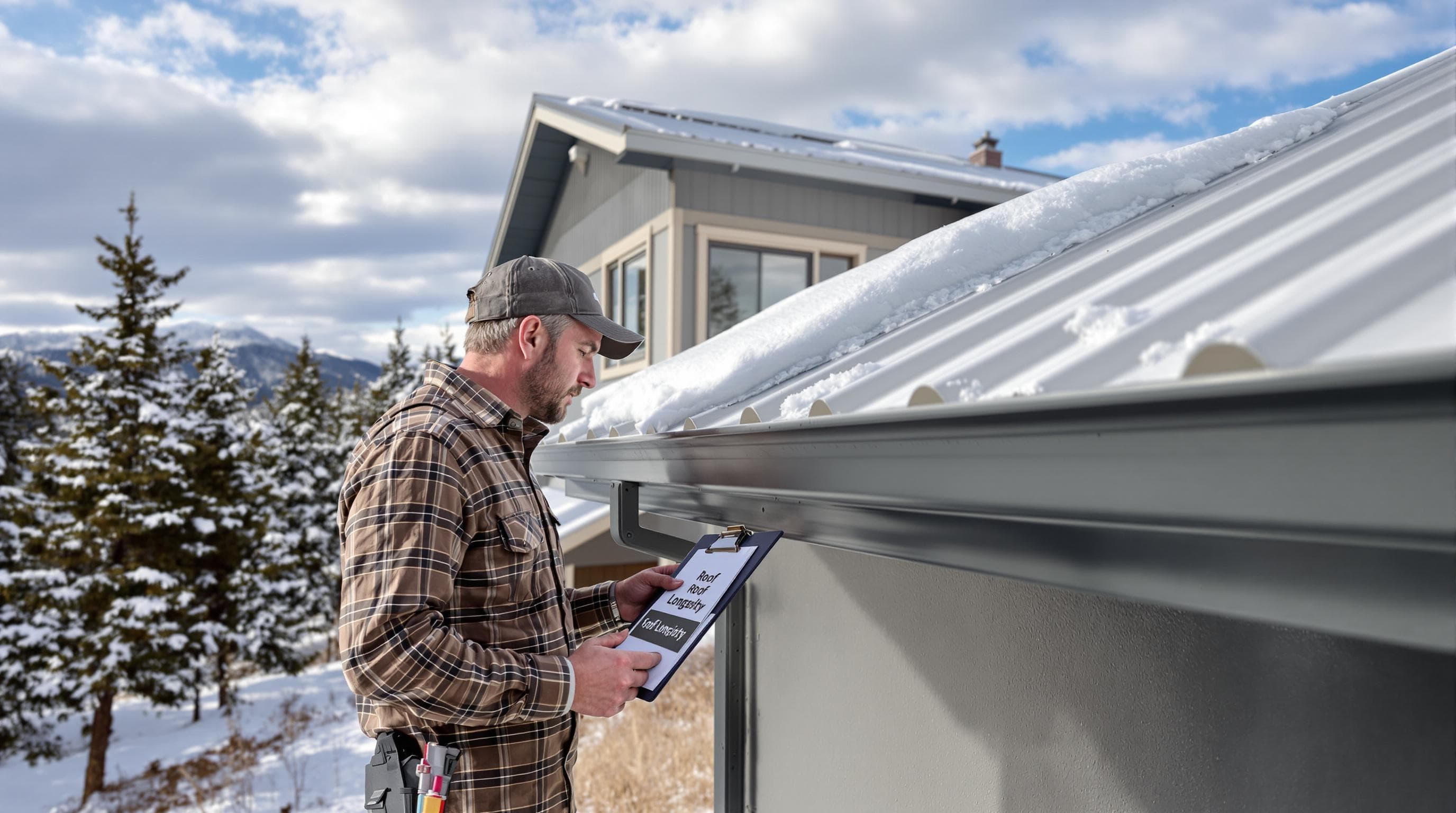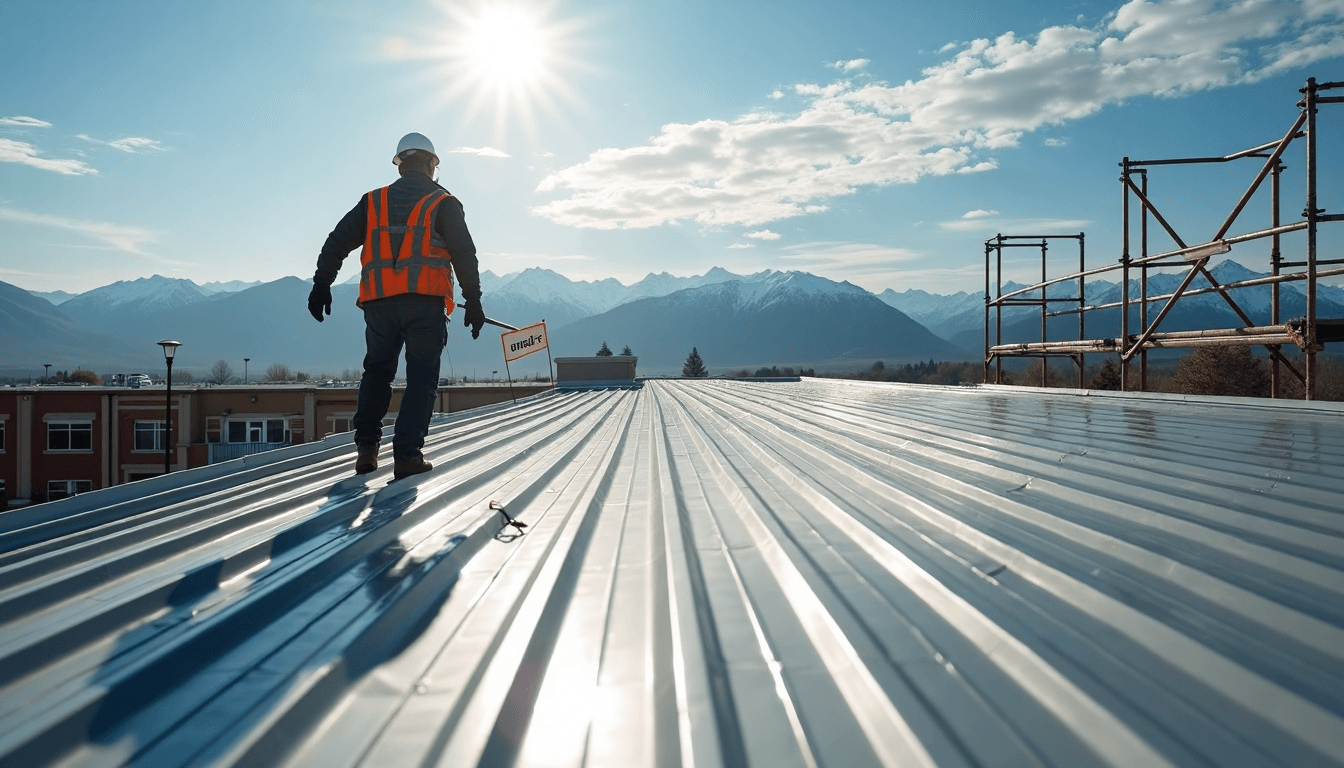Roof Design for Solar Panels: Helena & Montana's 2025 Guide
Contact Us
Roof Design for Solar Panels: Helena & Montana’s 2025 Guide
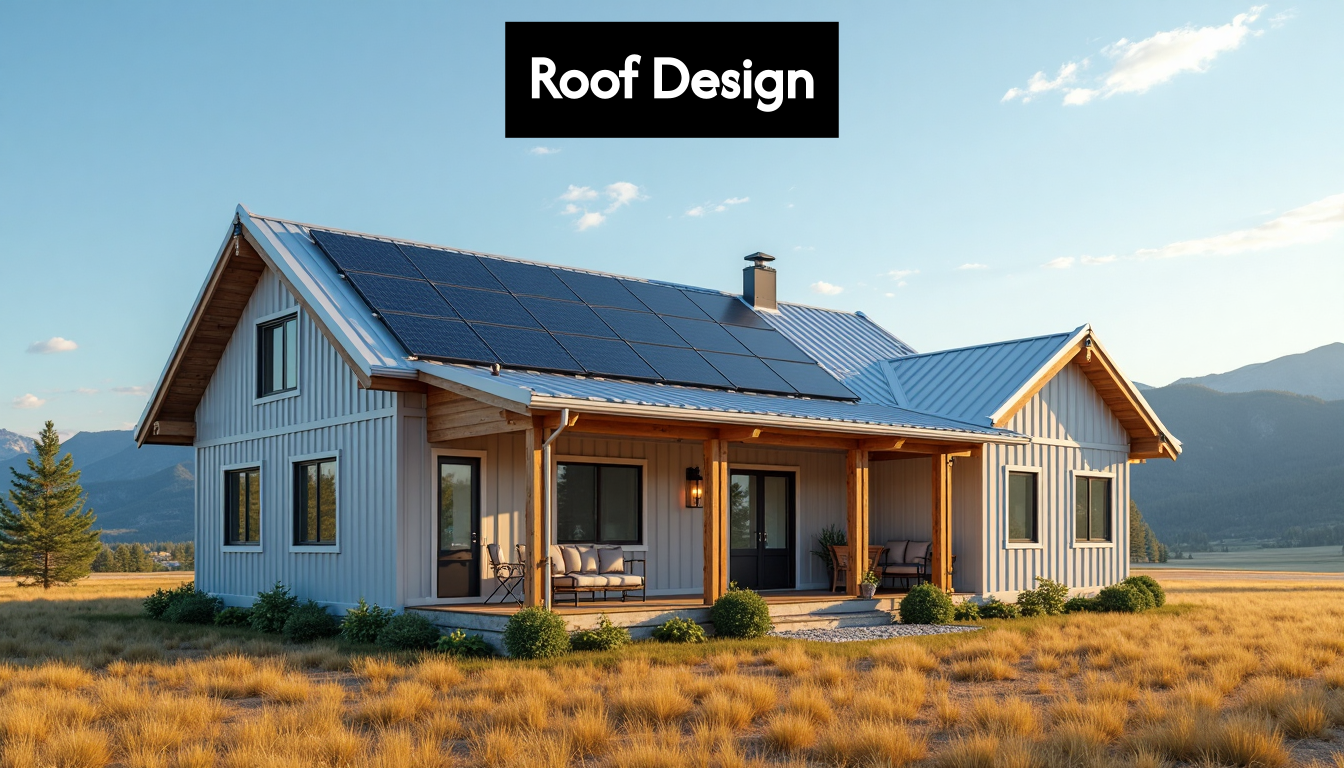
Roof design for solar panels is shaping up to be a key decision for homeowners in Helena and across Montana as more people look to energy independence. Most folks might assume metal roofs are just about durability or style. Here’s the curveball. Standing seam metal roofs not only outlast shingles by over 30 years but can also make solar installation easier, safer, and cheaper by eliminating the need for drilling holes. This one detail could save you future headaches and a lot of money, but it is not even the only factor Montana homeowners need to consider in 2025.
Table of Contents
Quick Summary
| Takeaway | Explanation |
|---|---|
| Choose the Right Roof Type | Metal roofs are ideal for solar panel installations due to their durability and ease of attachment. Asphalt shingles are common and can also support solar, but require more complex mounting. Flat roofs allow for adjustable mounting but need careful planning for optimal performance. |
| Optimize Roof Design for Local Climate | In Helena and Montana, south and west-facing roofs can yield significantly more electricity. Roof pitch should be between 30 to 45 degrees for best solar performance, and professional analysis is crucial to avoid shading and ensure efficiency. |
| Invest in Advanced Technologies | Utilizing bifacial solar panels can enhance energy generation by capturing sunlight from both sides. Incorporating battery storage systems enables better energy management by storing excess energy for later use, improving energy independence. |
| Understand Insurance Implications | Rising premiums and potential gaps in coverage for solar installations highlight the need for specialized insurance. Homeowners should document system specifications and maintenance to streamline claims and protect their investments. |
| Consider Future Energy Needs | Selecting an appropriately sized solar system that accounts for current and anticipated future energy demands helps maximize long-term efficiency and functionality. A comprehensive assessment by professionals can guide the right sizing decision. |
Best Roof Types for Solar Panel Installation
Choosing the right roof design for solar panels dramatically impacts your solar energy system’s performance, durability, and overall installation efficiency. Not all roofing materials are created equal when it comes to supporting solar technology, and understanding the strengths of different roof types can help homeowners make informed decisions.
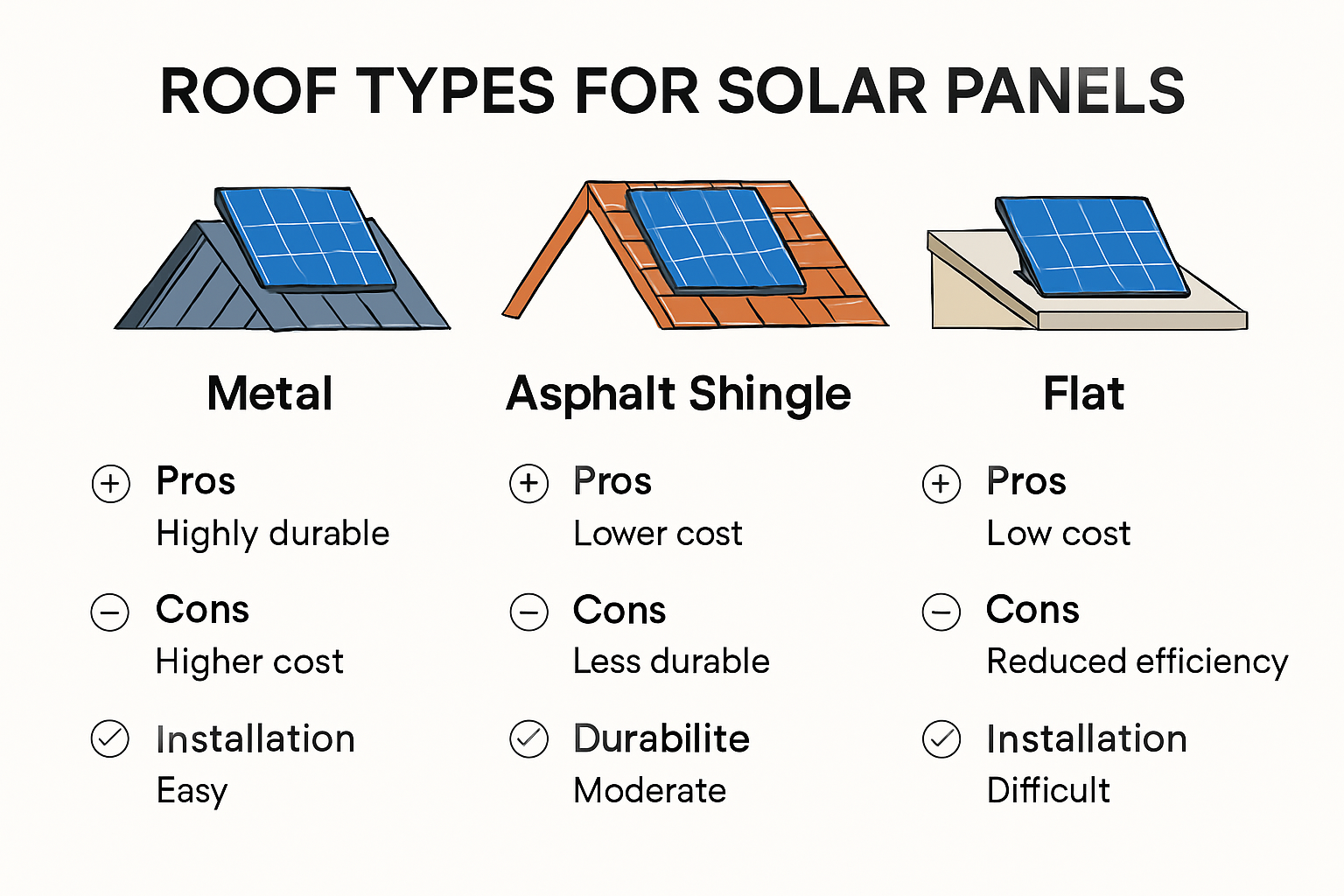
Metal Roofs: The Solar Installation Champion
Metal roofs stand out as the premier choice for solar panel installation. According to Sunsent Solar , standing seam metal roofs offer unparalleled advantages for solar mounting. The built-in seam design allows for secure panel attachment without drilling holes, which minimizes potential roof damage and water infiltration risks.
These roofs provide exceptional durability, often lasting over 30 years and perfectly aligning with most solar panel system lifecycles. Their reflective surface also contributes to improved solar efficiency by reducing heat absorption and maintaining optimal panel temperature. Homeowners can expect easier installation processes, lower long-term maintenance costs, and enhanced energy production when choosing metal roofing for their solar panel design.
Asphalt Shingle Roofs: The Most Common Solar Platform
Asphalt shingle roofs represent the most prevalent roofing material in residential construction, and fortunately, they are highly compatible with solar panel installations. Gain Solar notes that these roofs offer relatively low-cost bracket system installations, making solar adoption more accessible for many homeowners.
While asphalt shingles require more complex mounting techniques compared to metal roofs, professional solar installers can effectively secure panels using specialized racking systems. Homeowners should work closely with experienced technicians who understand the nuanced requirements of attaching solar equipment to asphalt surfaces, ensuring long-term structural integrity and preventing potential roof damage.
Flat Roofs: Flexible Solar Mounting Options
Flat roofs present unique opportunities for solar panel installation. As Gain Solar explains, mounting systems on flat surfaces can be precisely adjusted for optimal tilt and sun exposure. This flexibility allows homeowners to maximize solar energy production regardless of the roof’s original orientation.
However, flat roof solar installations require careful planning. Additional considerations include structural reinforcement, proper drainage management, and strategies for managing snow accumulation. Professional solar designers can create custom mounting solutions that address these challenges, ensuring your solar system performs efficiently while protecting your roof’s structural integrity.
When evaluating roof design for solar panels, consider factors beyond material type. Roof age, structural condition, sun exposure, and local climate all play crucial roles in determining the most effective solar installation strategy. Consulting with local solar and roofing professionals who understand Montana’s specific environmental conditions will help you make the most informed decision for your home’s solar energy future.
Key Design Factors for Helena and Montana
Designing solar panel roof installations in Helena and Montana requires a nuanced understanding of regional environmental conditions, energy requirements, and specific architectural considerations. Unlike standard solar design approaches, Montana’s unique climate and topography demand specialized strategies to maximize solar energy generation and system efficiency.
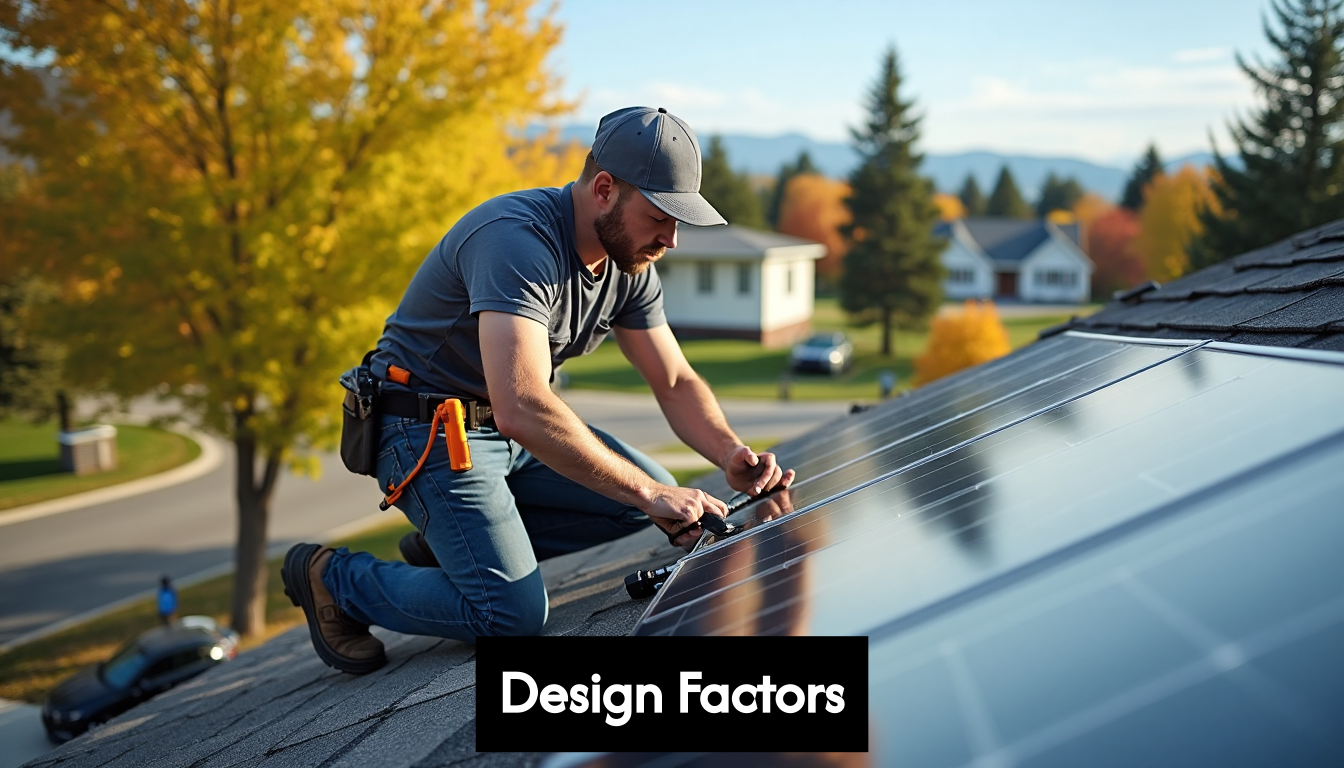
Roof Orientation and Sun Exposure Optimization
Roof orientation plays a critical role in solar panel performance. According to Ellingson Roofing Solar Efficiency Guide , south and west-facing roofs in Helena can generate up to 20% more electricity compared to less optimal orientations. This means homeowners must carefully evaluate their roof’s directional positioning to capture maximum sunlight throughout Montana’s varying seasonal conditions.
The ideal roof pitch for solar panels in Montana typically ranges between 30 to 45 degrees, which allows for optimal solar radiation absorption. Professional solar designers will conduct precise sun path analyses to determine the most effective panel placement, considering factors like potential shading from nearby trees, mountain terrain, and local landscape features that might impact solar collection.
System Size and Energy Production Requirements
Go Yellowball Solar Installation Guide highlights that the typical solar system size needed to offset a Montana household’s annual energy consumption is approximately 12.6 kW. This sizing depends on multiple factors including household energy usage, roof available surface area, and local electricity consumption patterns.
Homeowners must consider not just current energy needs but potential future changes. Factors like anticipated home expansions, electric vehicle charging requirements, and potential increases in household electricity consumption should be integrated into the initial solar design strategy. A comprehensive assessment by professional solar installers can help determine the most appropriate system size that balances immediate needs with long-term energy goals.
Regulatory and Climate Considerations
Montana’s regulatory landscape and unique climate present both challenges and opportunities for solar panel roof design. Ellingson Roofing’s Solar Installation Process Guide emphasizes the importance of understanding local permitting requirements, state-specific solar incentives, and installation regulations.
With an average of 201 sunny days per year, Montana offers substantial solar potential. However, the state’s cooler temperatures and potential for snow accumulation require specialized mounting systems and panel selections. Solar panels actually perform more efficiently in cooler temperatures, but installers must design systems that can withstand winter conditions, including snow load management and potential ice formation.
Successful solar panel roof design in Helena and Montana goes beyond simple installation. It requires a holistic approach that considers regional climate patterns, energy consumption trends, roof structural integrity, and local regulatory frameworks. Homeowners should partner with experienced local solar professionals who understand these nuanced requirements to create a truly optimized solar energy solution tailored to Montana’s unique environment.
Upgrades and Remodeling Tips for Maximum Efficiency
Rooftop solar upgrades and remodeling represent strategic investments for Helena homeowners seeking maximum energy efficiency and long-term performance. Modern solar technology and innovative design approaches can transform an ordinary roof into a powerful renewable energy platform.
Advanced Panel Technologies and Design Strategies
According to NY Engineers Rooftop Design Trends , incorporating bifacial solar panels during roof upgrades can boost energy yield by 11-15% compared to traditional panels. These cutting-edge panels capture sunlight from both sides, dramatically increasing energy generation potential, especially when installed on high-reflectance surfaces like white membrane roofs.
AI-powered design tools now enable unprecedented precision in solar installation planning. Professional installers can conduct comprehensive shading analyses, optimize panel layouts, and create custom configurations that maximize energy production. This technology allows homeowners to identify and eliminate potential inefficiencies before installation, ensuring every square foot of roofing contributes to energy generation.
Battery Storage and Energy Management
NY Engineers emphasizes that integrating advanced battery storage systems with rooftop solar has become increasingly essential. Modern lithium-ion batteries offer higher efficiency and lower costs, supporting greater energy independence and maximizing solar upgrade benefits.
Homeowners should consider battery systems that provide seamless energy storage and distribution. These systems can store excess solar energy generated during peak sunlight hours, allowing residents to use stored power during evening hours or during power interruptions. Some advanced systems even offer smart grid integration, enabling potential energy selling back to local utility providers.
Structural Reinforcement and Roof Preparation
Successful solar upgrades require meticulous roof preparation. Professional solar installers will conduct comprehensive structural assessments to ensure your roof can support new solar technologies. This evaluation includes examining roof material integrity, assessing load-bearing capacity, and identifying potential reinforcement needs.
Remodeling for solar efficiency often involves more than just panel installation. Homeowners might need to consider additional upgrades like improved roof insulation, reflective roofing materials, or structural modifications to optimize solar panel performance. Working with experienced local professionals who understand Montana’s unique climate conditions ensures that your solar upgrade delivers maximum long-term value.
Ultimately, solar roof upgrades represent a sophisticated blend of technology, design, and strategic planning. By leveraging advanced panel technologies, intelligent energy storage solutions, and professional installation expertise, Helena homeowners can transform their roofs into high-performance renewable energy platforms that deliver significant economic and environmental benefits.
Navigating Insurance and Claims for Solar Projects
Solar panel installations introduce unique complexities to property insurance and claims processes for Helena homeowners. Understanding the intricate landscape of insurance coverage, potential risks, and proactive protection strategies becomes crucial for successful solar project management.
Rising Insurance Premiums and Coverage Challenges
Project Finance Law reports significant shifts in solar project insurance, with premiums increasing between 15% to 45% across the industry. These increases stem from inflation, supply chain disruptions, and a growing number of weather-related damage claims, particularly in regions like Montana with challenging environmental conditions.
Homeowners must recognize that solar panels represent a substantial investment requiring specialized insurance considerations. Traditional homeowners insurance policies may not automatically cover solar installations, necessitating specific endorsements or separate solar equipment coverage. Working closely with insurance providers who understand solar technology and local environmental risks becomes essential for comprehensive protection.
Claims Management and Damage Prevention
Ryan Specialty Insurance Review highlights that rooftop solar installations are increasingly vulnerable to damage, often representing the most exposed component of residential structures. Nearly 50% of homeowners insurance claims relate to wind and hail damage, making proactive maintenance and risk mitigation critical for solar-equipped homes.
Professional solar installers recommend comprehensive documentation of system specifications, installation processes, and regular maintenance records. These documents can significantly streamline insurance claims processes and provide substantial evidence of proper system care. Homeowners should maintain detailed photographic records, professional inspection reports, and manufacturer warranties to support potential future claims.
Strategic Insurance Planning for Solar Projects
Sunsent Roofing Trends Report emphasizes the importance of strategic insurance planning for solar investments. Homeowners should consider specialized solar equipment insurance riders that provide comprehensive coverage beyond standard homeowners policies.
Key insurance considerations include evaluating total replacement costs, understanding coverage limits for solar equipment, and assessing potential gaps in existing policies. Some insurers now offer dedicated solar equipment endorsements that cover panel damage, performance degradation, and associated electrical system components. Montana homeowners should seek insurers with experience in renewable energy systems and local environmental challenges.
Successful Montana solar project insurance management requires a proactive, comprehensive approach. By understanding potential risks, maintaining thorough documentation, and working with knowledgeable insurance professionals, Helena homeowners can protect their solar investments and ensure financial security against potential unexpected damages or performance issues.
Frequently Asked Questions
What is the best roof type for solar panel installation in Montana?
Metal roofs are considered the best option for solar panel installations due to their durability, ease of attachment, and long lifespan. Standing seam metal roofs, in particular, allow for secure panel mounting without the need for drilling holes, minimizing the risk of water infiltration.
How does roof orientation affect solar energy production?
Roof orientation significantly impacts solar energy production. In Helena, south and west-facing roofs can generate up to 20% more electricity compared to other orientations. The ideal roof pitch for optimal solar performance typically ranges from 30 to 45 degrees.
What factors should I consider when sizing my solar system?
When sizing your solar system, consider your current and anticipated future energy needs, such as household expansions or electric vehicle charging requirements. A professional assessment can help determine the appropriate system size based on your roof’s available surface area and local electricity consumption patterns.
How can I protect my solar investment through insurance?
To protect your solar investment, work with insurance providers that offer specialized coverage for solar installations, as traditional homeowners policies may not cover solar panels. Maintaining detailed records of installation processes and regular maintenance can streamline insurance claims and provide substantial evidence for any future claims.
Ready to Transform Your Roof for Solar Success in Helena?
Choosing the right roof for solar panels in Montana is about more than picking a material. The article highlighted big challenges like snow loads, sun exposure, roof orientation, and insurance worries. Many homeowners feel overwhelmed by technical details and worried about making an expensive mistake. If you want to avoid water leaks, maximize sun power, and ensure your insurance is solid, you need a partner who understands Helena’s unique climate and can deliver a roof that actually supports long-term solar performance.
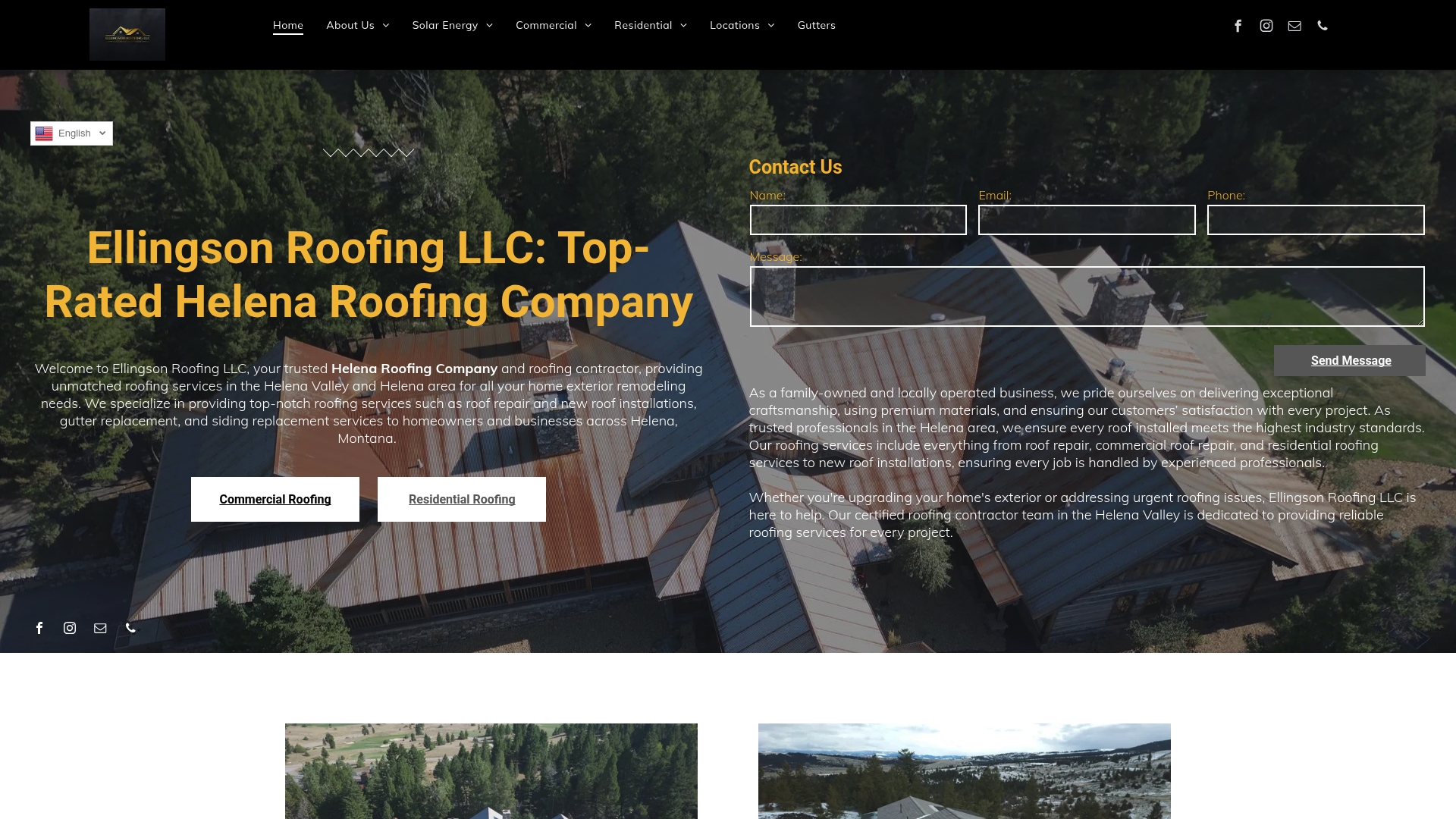
Protect your investment and power your future by working with a local team that handles everything from solar-ready roof design to insurance documentation. Contact Ellingson Roofing LLC today for a personalized solar and roofing evaluation. Our experts will guide you through smart material choices, durable installation, and seamless solar integration. Book your free estimate now and give your Helena home the strongest foundation for solar in 2025.

